My Search Programs for Minelab E-Trac and CTX 3030 Metal Detectors
Search Program #1 - Level 3 - "Minimum Discrimination", page 22
DISCRIMINATION and QUICKMASK PATTERNS for Level 3 Program Settings
(...CONTINUED from Previous Page)
Discrimination Patterns
As you may have noticed the summaries of program settings of all three levels differ from one another a little - just by two or three items. This is because Discrimination patterns and personal skills of an operator actually play bigger roles. While the latter comes with practice, experience and time, the best Discrimination patterns are created through a lot of experimentation, thinking and optimization. And it is important to follow the main principle of using Discrimination: the amount of it to be implemented should be determined based on what one would like to find rather than what should be rejected. But what really counts is how effective this Discrimination pattern works in conjunction with other key-features and settings of a metal detector under current search conditions.
Although the following Discrimination pattern works best in areas where I metal detect, it may not be equally efficient in your area. This is why you should experiment with my Discrimination pattern as the basis for your own patterns to be used with different combinations of program settings. Another important thing to keep in mind is that you need to allow your detector to respond to some rusty nails in order to hear the good targets lying close to them or being partially masked by them. You should use as little iron discrimination as possible. It is easier to do with CTX 3030 than with E-Trac, and that is a big difference between the two.
To detect deep, small and partially masked coins and non-ferrous targets among iron nails at the "hunted out" sites, I recommend to use the following Discrimination pattern:
Minelab E-Trac and CTX 3030 Discrimination Pattern for Level-3 "Coins" Search Program
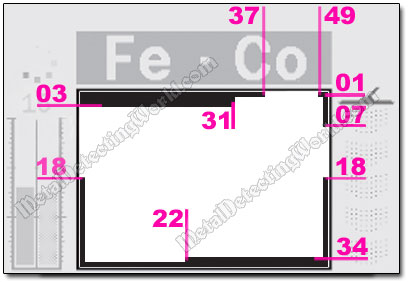
This pattern of minimum Discrimination provides elimination of the detector's responses to:
1) iron falsing caused by the "wrap around effect" (partially blackened lines FE-01,FE-02, FE-03, FE-35, CO-01 and CO-50). With an exception of the FE-01 line, all other lines can be entirely blackened if the iron falsing remains excessive. The white gap on the FE-01 line accepts large silver and copper coins.
2) some nails with the FE-CO properties that "occupy" the lower right corner of the FERROUS area (area below the FE-17 line) in the Smartfind window (Smartfind 2 window on the CTX 3030). This corner is never occupied by the FE-CO properties of coins that may be "disguised" by close iron trash or high mineral content.
On the E-Trac's Smartfind window, the boundary - the FE-17 line, between the Conductivity and Ferrous zones is permanent, and each zone is assigned a tone pitch of certain frequency in the "2-Tone FERROUS" mode. On the CTX 3030's Smartfind 2 window, the boundary between two tone bins can be moved up or down (bin resizing), and each bin can be assigned any tone pitch you like in the "2-Tone FE" mode. I set up the tone boundary between the low and high tones at the FE-22 line. A special attention is required to responses "landing" between the FE lines 17 and 22.
CTX-3030 1st Discrimination Pattern for Level 3 Search Program with "2-Tone FE" Tone ID Map
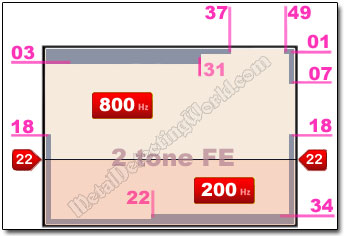
If the ground mineral content is low, you should consider using "50-Tone CO" for the Tone ID Profile with this Discrimination pattern in conjunction with the FERROUS-COIN Target Separation mode, the 'ENABLE GB-OFF' and TARGET TRACE feature. The results may surprise you!
CTX-3030 1st Discrimination Pattern for Level 3 Search Program with "50-Tone CO" Tone ID Map
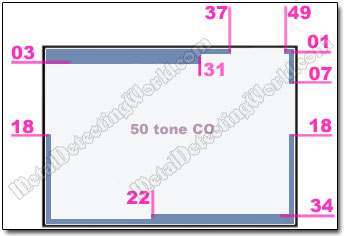
E-Trac's QuickMask and CTX 3030's 2nd Discrimination Patterns
To check and confirm the FE-CO properties of questionable targets and rejected iron objects, I use the same Discrimination pattern for the E-Trac's QuickMask and the CTX 3030's Second Discrimination pattern as the pattern I use in the Level 1 and 2 search programs.
E-Trac's QuickMask Pattern for TTF "Coins" Level 3 Search Program
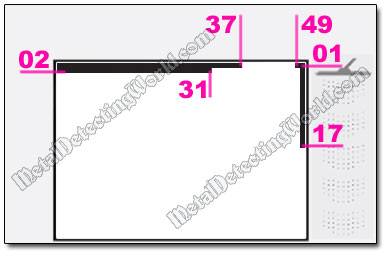
You can assign a different Tone ID Profile to the CTX 3030's 2nd Discrimination pattern if you create a new User Mode with the Level 3 program settings but with its own Tone ID Map (see details here) looking, for example, like this:
Minelab CTX-3030 Second Discrimination Pattern for Level-3 "Coins" Search Program
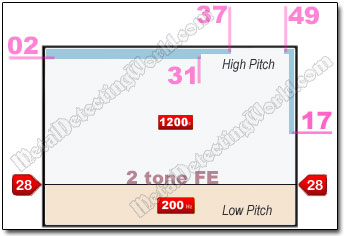
You can assign an audio tone of any frequency you like to each bin. Experiment with different frequencies to make sure you can hear difference between two "neighboring" audio tones, and you are comfortable with your selection. The tone frequencies (represented by white numbers on red buttons) shown in the Audio Setup above are NOT the exact actual frequencies. Each number only represents the frequency range assigned to a corresponding bin.
This Level 3 Search Program is just a starting point for developing your own program according to your preferences and metal detecting conditions. My program is only to help you in doing your home work. Use the program for experimenting with various targets in field conditions, and see what settings work the best for you.
After you fine-tune your Level 3 Search Program, you should use it again at your favorite sites after the winter frosts turn more coins in a detectable position!
Please let me know your opinion on my program after you use it. You are welcome to submit some pictures of your finds recovered with my program. I would appreciate any suggestions, tips, and constructive criticism. If you have a program for Coin Shooting at Iron Infested Site, that you believe is more productive than mine, and you would like to share it with the community, please e-mail me your program! I would be happy to post it here. Good Luck and Happy Hunting!
Make a Donation
Please help me stay afloat, afford more metal detecting trips with field-tests and experiments to create more informative articles, useful tutorials and helpful guides for detectorists, and maintain this website - the most informative hobby resource on the web! Since I do not have any steady income, any donation matters to me a lot! Thank you kindly!
Clicking on the donate button will take you to a donation page powered by Donorbox and dedicated to my website (MetalDetectingWorld.com). The donation page is PCI-compliant, secured by SSL/TLS, and has a simple form to fill out. Donorbox does not store any card or bank data. Credit card information is encrypted and tokenized by the Stripe payment processor.
This website would not exist without the advertisements we display and your kind donations. If you are unable to support us by viewing our advertisements, please consider making a Donation to ensure the future of this website. By helping me keep this website alive and growing, you will sure help many detectorists around the world as well!
ANNOUNCEMENT:
In January of 2020, I started a one-time fund-raising campaign in attempt to accumulate enough money to buy a simple but reliable 4x4 vehicle. My old 4x4 car (made in 1995) had faithfully served me for 10 years before it eventually went beyond repair last October. Without a 4WD, I will not be able to get to my hunt sites and test-plots hidden in the remote wooded areas inaccessible by a regular car.
Unlucky for me, those sites are the only locations available and suitable for my field-work which results in informative articles you can find on this website. For the past 10 years, my usual field-work has consisted of field-testing the latest metal detectors and accessories, experimenting with some of them, and devising new effective search methods that meet the requirements of the new metal detecting reality.
Before my car died, I managed to finish a couple of interesting detector-testing projects which will be covered in my upcoming articles. But other equally important projects that I was working on were not completed and had to be postponed until the Spring 2020. I hope that this fund-raising campaign will help me get a decent 4x4 by then so that I will be able to resume my work and to write more new articles, tutorials and guides based on data gathered through testing and experimentation.
If you find my website useful and would like it to provide more essential info for you and other detectorists worldwide, please consider chipping in $5, $20, $50 or whatever you can afford to keep MetalDetectingWorld.com growing in 2020. I promise you, it will be money well spent. Thank you.
Donate- Please help me promote this article:
If you would like to follow me on Twitter, please press a button:
I have my profile page on
where you can share your thoughts on this article, ask me a question, or place a friend request.I also have my profile pages on Pinterest, LinkedIn, Tumblr, Reddit and Delicious
and my "Metal Detecting World" page on Twitter, Pinterest and Tumblr
I no longer maintain my old Facebook page